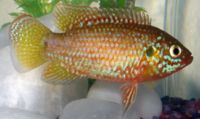Difference between revisions of "Hemichromis bimaculatus"
From The Aquarium Wiki
m |
|||
| Line 36: | Line 36: | ||
|max_water_hardness=16 | |max_water_hardness=16 | ||
}} | }} | ||
| − | + | ||
| − | + | == Origin == | |
| − | + | :Africa: Widely distributed in West Africa, where it is known from most hydrographic basins, associated with forested biotopes. Also reported from coastal basins of Cameroon, Democratic Republic of the Congo and Nile basin | |
| − | + | ||
| − | + | ||
| − | + | == Sexing == | |
| − | + | :The females tend to be larger and the males more colourful. | |
| − | + | ||
| − | + | ||
| − | + | == Tank compatibility == | |
| + | :As with most Cichlids, these fish should be considered semi-aggressive and incompatible with community fish. | ||
| + | |||
| + | |||
| + | == Diet == | ||
| + | :This fish will accept pellets and flake as well as algae-based foods. They will eat live plants. | ||
| + | |||
| + | |||
| + | == Feeding regime == | ||
| + | :Feed once or twice a day. | ||
| + | |||
| + | |||
| + | == Environment specifics == | ||
| + | :These fish need spacious tanks with plenty of hiding places and caves. | ||
| + | |||
| + | |||
| + | == Behaviour == | ||
| + | :This fish should be considered aggressive. It is primarily mid-top dwelling. | ||
| + | |||
| + | |||
| + | == Identification == | ||
| + | :A colourful oval-shaped fish that is red-orange in base colour, with many iridescent blue spots covering the body and fins,they have two dark spots on the flanks. There are hybrids also seen, these lack the dark spots. | ||
| + | |||
| + | |||
{{Categories | {{Categories | ||
|Category=Fish, Fish (Freshwater), Cichlids, Cichlids (African), Cichlids (Other Lakes) | |Category=Fish, Fish (Freshwater), Cichlids, Cichlids (African), Cichlids (Other Lakes) | ||
Latest revision as of 02:58, 13 December 2017
Jewel Cichlid
Hemichromis bimaculatus
170 Litres (45 US G.)
13-14 cm (5.1-5.5")
Freshwater
6.5 - 7.5
21 -23 °C (69.8-73.4°F)
4-16 °d
1:2 M:F
5-8 years
Family
Cichlidae
Contents
Additional names
- Jewel Fish, Jewel Cichlid, Jewelfish, Two-Spot Jewel Cichlid, Red Jewel Cichlid, African Jewelfish
Additional scientific names
- Hemichromis cristatus
Origin[edit]
- Africa: Widely distributed in West Africa, where it is known from most hydrographic basins, associated with forested biotopes. Also reported from coastal basins of Cameroon, Democratic Republic of the Congo and Nile basin
Sexing[edit]
- The females tend to be larger and the males more colourful.
Tank compatibility[edit]
- As with most Cichlids, these fish should be considered semi-aggressive and incompatible with community fish.
Diet[edit]
- This fish will accept pellets and flake as well as algae-based foods. They will eat live plants.
Feeding regime[edit]
- Feed once or twice a day.
Environment specifics[edit]
- These fish need spacious tanks with plenty of hiding places and caves.
Behaviour[edit]
- This fish should be considered aggressive. It is primarily mid-top dwelling.
Identification[edit]
- A colourful oval-shaped fish that is red-orange in base colour, with many iridescent blue spots covering the body and fins,they have two dark spots on the flanks. There are hybrids also seen, these lack the dark spots.
Pictures[edit]
Videos[edit]
| Spawning Behaviour: | |
External links[edit]
- Fishbase (Mirrors:
 )
)

